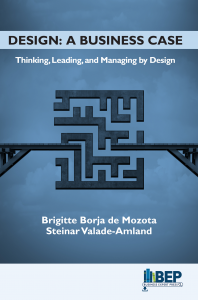Main Content

“Never before did design capture as many agendas simultaneously.”
Brigitte Borja de Mozota and DBA Expert Steinar Valade-Amland share a few observations from the past year in the introduction to their new book ‘Design: A Business Case’. With the global crisis releasing a wealth of tacit design thinking, what does this reveal about the future potential for design?
 “One of the most encouraging observations was how agile and adaptable thousands of companies around the world proved in response to the situation. The COVID-19 crisis has evidenced how design activity flourishes – on at least three different levels – when extreme disruption of “business as usual,” external constraints, and sudden, dire needs drive innovation.
“One of the most encouraging observations was how agile and adaptable thousands of companies around the world proved in response to the situation. The COVID-19 crisis has evidenced how design activity flourishes – on at least three different levels – when extreme disruption of “business as usual,” external constraints, and sudden, dire needs drive innovation.
Influencing outputs.
Coming from high-tech as well as traditional manufacturing industries, companies – multinationals and SMEs alike, as well as individual professionals from design and engineering, business and the arts – took on the challenge of addressing and giving tangible answers to a series of unarticulated yet universally understood briefs.
They developed new products, new production lines, new assembly methods – even new materials – to serve a global market in need of protective gear, respiratory products, and other items of which the world experienced a sudden and life-threatening shortage but, clearly, also to survive a situation where traditional markets collapsed and supply chains vanished. Such adaptiveness and agility have never been seen before, and it only proves what an untapped potential for design thinking and design actually exists out there.
Influencing organisations and institutions.
At the same time, we’ve seen a mind-blowing civic engagement and creativity. New grassroots movements have emerged, developed services, established distribution channels, and filled unmet needs, mostly on a voluntary basis, but still a manifestation of the spare capacity out there.
And for those who were lucky enough to hold on to their jobs, new ways of working grew out of needs and accumulated, however often mostly through trial and error; ways that overnight became the rule rather than the exception. Never before have digital capabilities been boosted as fast and as effectively among baseline users as during spring 2020.
Influencing frameworks.
Perhaps less overt, and yet possibly with a more significant and also more lasting effect, are some of the discourses emerging in the wake of the crisis. People are starting to question whether capitalism as we know it needs reinventing and whether the values and structures on which we build our societies are resilient enough to withstand crises of such a magnitude. Questions also include whether new forms of leadership are needed; more systemic and more collaborative narratives – across borders and in recognition of the mutual dependence that globalization imposes on us. In the aftermath of crises, great visions are born, new stories and new identities.
All this tells us that disruption and despair are catalysts for creativity and hidden talents. It also tells us that lateral thinking has become a premise, rather than frosting on the cake.
‘The design process is a convenient format for developing the idea of lateral thinking. The emphasis is on the different ways of doing things, the different ways of looking at things and the escape from cliché concepts, the challenging of assumptions.’1
Never before were challenging assumptions more appropriate, more important. And never before did design capture as many agendas simultaneously.”
 The above article is an extract from the introduction to ‘Design: A Business Case – Thinking, Leading and Managing by Design’.
The above article is an extract from the introduction to ‘Design: A Business Case – Thinking, Leading and Managing by Design’.
‘Design: A Business Case’ challenges you to stimulate innovation in your own organisation, to make design a dialogue between complementary skills, to see design as a bridge between mind and matter, image and identity.
Authored by Brigitte Borja de Mozota and Steinar Valade-Amland, further details about the publication can be found here.
Steinar Valade-Amland is a DBA Expert.
Find out more about how the DBA Register of Experts can support your business.
- E. de Bono. 1970. Lateral Thinking – A textbook of Creativity (London, UK: Penguin Books).
Image credits:
Simon Peel | Unsplash
Mike Enerio | Unsplash
‘Design: A Business Case’ cover image